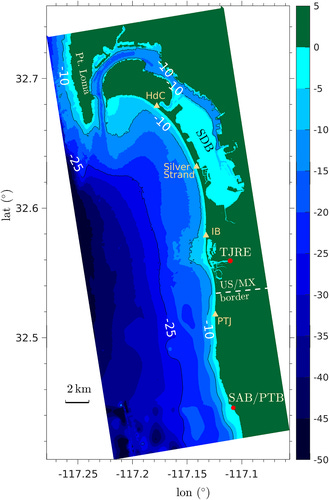How much sewage are you surfing in?
Remember when the only forecast we cared about was wave height and wind direction? Now we've got scientists at Scripps creating weather forecasts for actual sewage, and honestly, it's about time.
The Southern California Coastal Ocean Observing System just released their Pathogen Forecast Model, predicting sewage concentrations up to five days out for beaches from Coronado to Playas de Tijuana. The system uses color-coded risk levels that make checking surf reports feel quaint by comparison.
Dr. Falk Feddersen and his team developed this tool because the San Diego-Tijuana border region has been dealing with a sewage crisis. Raw sewage flows into the ocean from the Tijuana River and the San Antonio de los Buenos treatment plant just south of the border. When ocean currents carry this contaminated water northward, San Diego County beaches become a biological hazard zone.
The model works like a weather forecast for pollution, processing data on winds, tides, offshore currents, waves, and river flow to predict where sewage will end up (my first paper shows that internal waves also play a role in this, but that will come eventually). Red zones indicate high risk with greater than 0.1% sewage concentration - that's a 10% chance of getting seriously sick if you go in the water. Yellow shows moderate risk, and green signals low risk.
Let’s put a disgusting image in your head. An average bathtub can hold about 50 gallons of water and 0.1% of 50 gallons is 0.05 gallons, or just under one cup. Of sewage. That means that any time the model is showing red, you’re swimming in waters that you could make at home by adding a scoop from the toilet to your tub.

Imperial Beach has been closed for over 1,000 consecutive days because of sewage contamination. That's nearly three years of red flags.
Swallowing even small amounts of sewage-polluted seawater can trigger gastroenteritis - the fancy medical term for having your guts turned inside out for days. The bacteria and viruses in human waste cause stomach inflammation that results in vomiting, abdominal cramps, and diarrhea lasting anywhere from 12 hours to four weeks. Beyond stomach troubles, sewage exposure can cause chest infections, ear and throat infections, skin rashes, and conjunctivitis. More seriously, hepatitis A and dangerous E. coli strains can cause liver damage and life-threatening complications.
Surfers face particular risk because we inevitably swallow water during wipeouts, duck dives, and those moments when a wave introduces your sinuses to the Pacific. Studies show that even brief exposure to contaminated water significantly increases the risk of gastrointestinal illness.

Previously, beach closures happened after contamination was detected, often 24 hours too late. The Pathogen Forecast Model flips this by predicting conditions before you paddle out. The system runs complex simulations requiring the computing power of 53 laptops working together for five hours to generate each forecast.
The model isn't perfect - it's still experimental and subject to errors like any forecast system. But it's a massive step forward in giving water users the information they need to stay healthy while politicians and engineers work on longer-term solutions to the sewage crisis.
For the San Diego locals, take it seriously. These are baseline levels, not even the huge increases that come after a good rain.
Further Reading:

